We frequently focus our user research around ways to measure improvements. But first, we need to identify a baseline. After all, the only way to measure how much better a new user experience is, is to understand where we came from. And one of the easiest, and most efficient ways to measure the baseline experience is to send out surveys.
Surveys allows us to gather a lot of information about users’ requirements and expectations. We can then use that information to adjust a product or service to fit their needs. In addition, surveys:
- Enable us to question large groups of participants
- Can be done remotely
- Are relatively cheap
- Allow large amounts of data to be gathered quickly
Creating a survey isn’t difficult, but to do it well takes preparation and practice. This article will provide a how-to, along with some best practices to follow.
Planning and objectives
Before we write down any survey questions, we need to think through what we want to accomplish, and who will help us get the information we’re seeking.
Determining goals
Before the main goal of the survey can be defined, the researcher has to fully understand the overall objectives. The best way to do that is by conducting stakeholder interviews. When I was preparing a recent customer survey for a web development company, I spoke with developers, project managers, communication managers, and team leaders at their organization. As a result, I got the full picture of the company: their mission, their services, the types of customers they work for and the main touch points they have with their customers. This knowledge helped me determine one main goal for the survey:
To reveal customer expectations through the different stages of their relationship with the web development company and to assess whether different groups of customers (e.g. designers, business owners, creative agencies) have different expectations.
Notice that there is only one main goal determined, which helps focus our survey and prepare relevant questions. In some cases, however, it may be useful to add an additional, minor goal that might be addressed in only one or two questions.
Selecting participants
Once the team agrees on the main goal of the survey, we need to determine who we are sending the survey to. We need to take into account the potential participants’ demographics, environment, and connection to the organization.
Demographics
First, we can narrow participants by details such as their age, nationality, or lifestyle. We want to find participants who match the company’s target demographic, whether that means people who work in a particular industry, or people who live in a certain area. We also want to consider how a participant’s lifestyle may impact how we set up the survey. For example, if our participants mostly speak English as a second language, we need to simplify the grammar and vocabulary we use in the survey.
Environment
Next, we need to consider the context where (and when, and how) participants will be completing the survey. If our survey objectives will require long, open-ended questions, we need to warn participants so they don’t attempt to answer the survey from their mobile phones. Alternatively, if the participants are unlikely to answer the survey unless they’re able to do it via phone during a lunch break, we might need to reevaluate how important the long, open-ended questions are.
Relationship with the company
Even after we know the company’s target audience, that group of participants might have subsets. For example, if the company is targeting college students who ski, some of those students will have been customers for years, where others have only interacted with the company once.
Understanding the relationship between the respondents and the company will help us prepare relevant questions. For example, we wouldn’t ask a one-time customer to assess whether the quality of service has improved over the past few years.
Choosing a research method: quantitative vs qualitative
Finally, we need to decide whether the survey will be quantitative or qualitative. In the case of my web development client, their goal was “to reveal customer expectations,” implying they would require open-ended, qualitative information.
The main goal of qualitative research is to gather an in-depth understanding. Focused on answering why and how, it is used to gather users’ opinions, reasons and motivations. Quantitative research, on the other hand, is based on gathering numerical data. Its aim is to answer questions such as what, how much, and how many. Quantitative methods help in prioritizing things and deciding whether certain ideas are worth to be developed.
Surveys are most frequently used as a quantitative research method because it’s difficult to follow up with the respondents, the way we might in an interview or some other, easier qualitative method. However, in the case of my web development client, we felt that the benefits of using a survey to reach such a large group of people outweighed the difficulty in following up with users.
Parts of a Survey
The best surveys include four parts: introduction, screening questions, measurement questions, and an ending. These four areas help bring the respondent along a journey, just as we would create for any other experience. While it doesn’t matter which part of the survey is created first, all four need time and attention.
Introduction
Since surveys are in most cases conducted remotely, the welcome message is very important. A short but clear introduction should explain the purpose of the questionnaire as well as identify who created it, and how long it takes to be completed. If the survey covers personal or private matters, this is also the place to add a confidentiality statement All of this is a form of expectation setting. Last but not least, highlight the importance of the respondent’s input—it will make him or her feel that their opinion is valuable.
In one welcome message that I used in a customer survey, I created an avatar to welcome the customer. Our introduction was only 3 sentences long:
Hello dear Customer
I’m Cody from Chop Chop.
I would like to invite you to take part in a quick survey about web development services.
These 6 minutes of your time can really help Chop-Chop team to improve and make you more satisfied with our services.
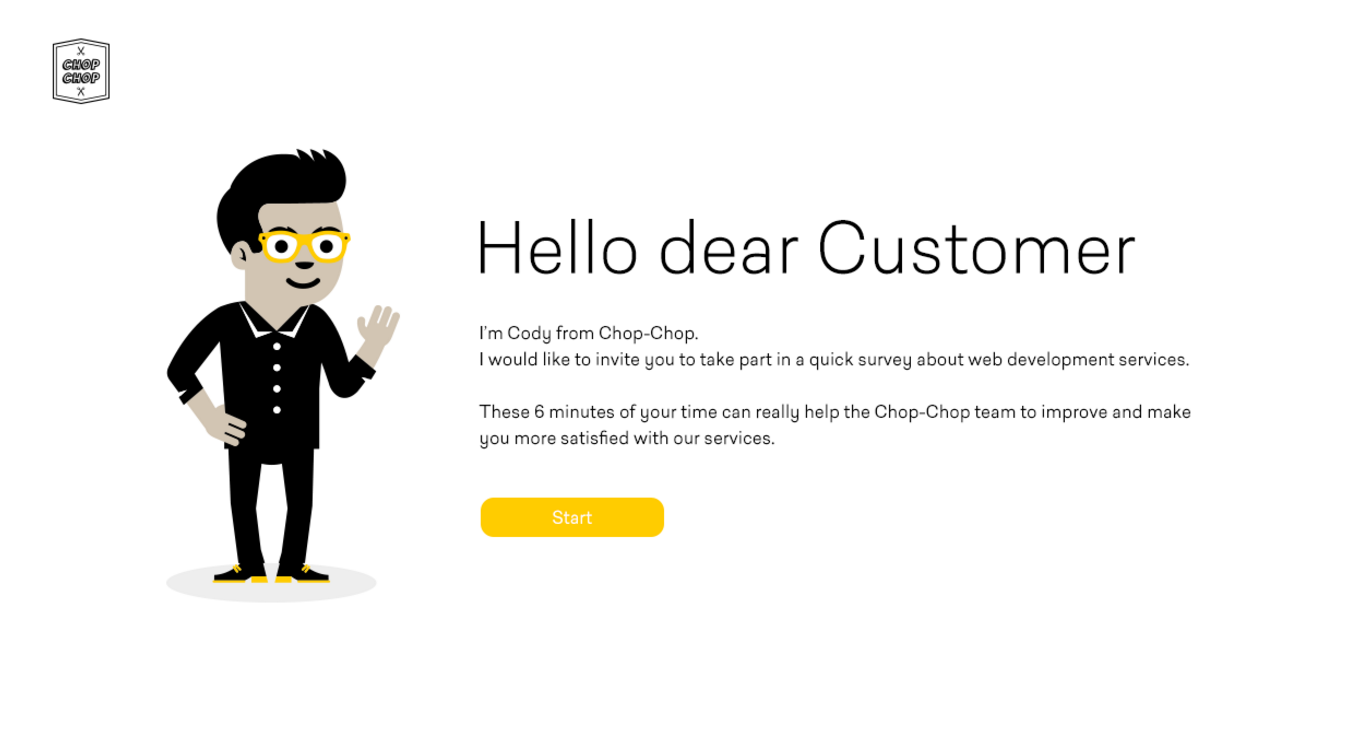
Screening questions
The main purpose of screening questions is to determine whether respondents have the characteristics and requirements needed to take part in the survey. For example, when sending out a survey about the customer experience of an online footwear shop, the first question could be: “Have you ever bought shoes online?” Screening questions guarantee the results of the survey are meaningful and relevant.
Another advantage of screening questions is that they help us differentiate when we have multiple groups of respondents. In the survey for the web development company, for example, our target audience included freelancers, business owners, and agencies. The screening questions helps me separate out these three groups.
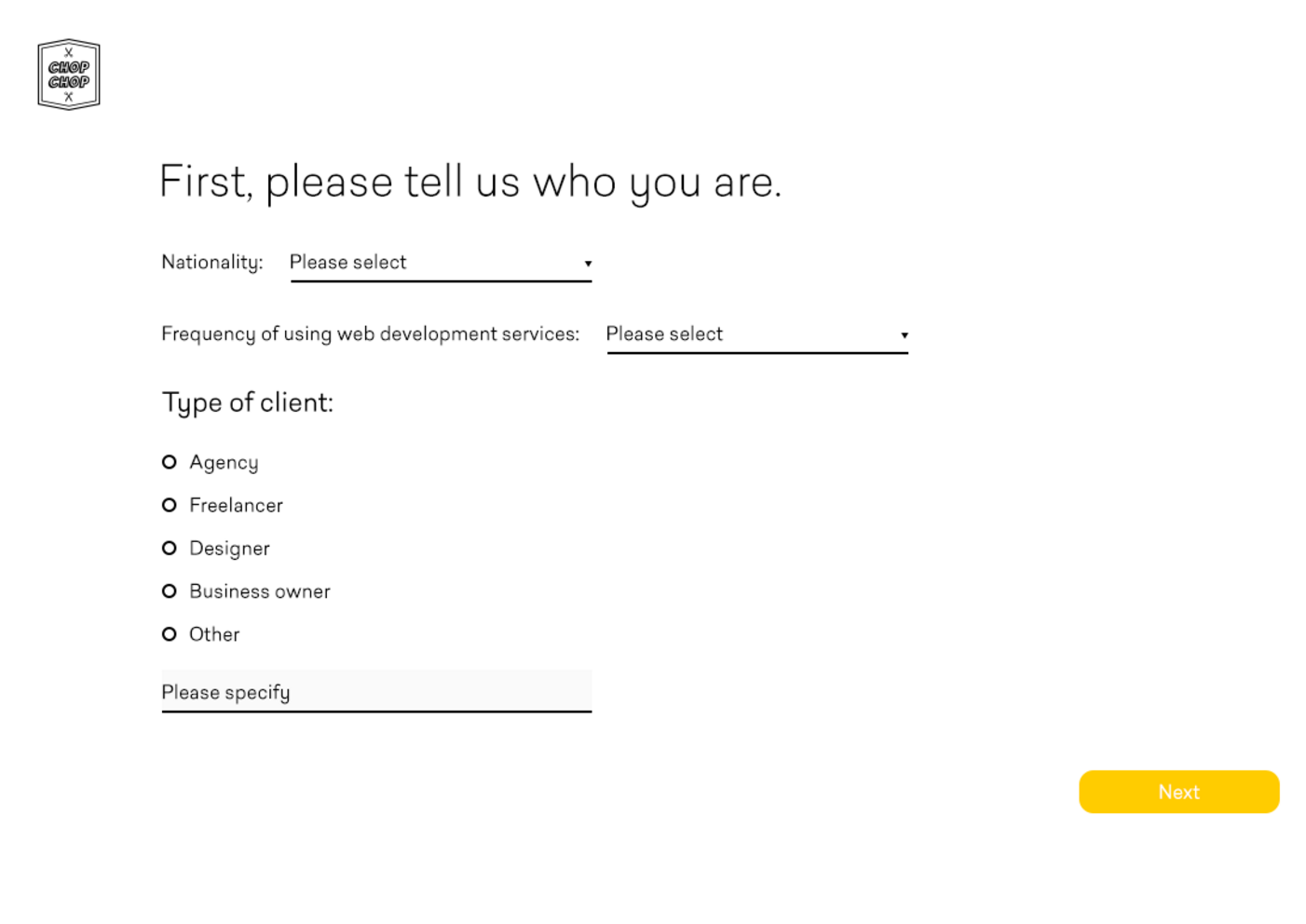
Measurement questions
This is the meat of the survey: the questions that will provide us with the information we’re seeking. There are two main kinds of questions in surveys: closed-ended and open-ended. Both have advantages and disadvantages.
Open-ended questions are particularly useful for qualitative research: they allow an infinite number of possible answers, and enable respondents to describe their feelings and thoughts. Open-ended questions are most useful when there’s a small group of participants, involved with the subject enough to share detailed thoughts and responses. In fact, one or two open-ended questions may be added to almost any kind of survey. However, they shouldn’t be obligatory if the main purpose of the survey is quantitative research.
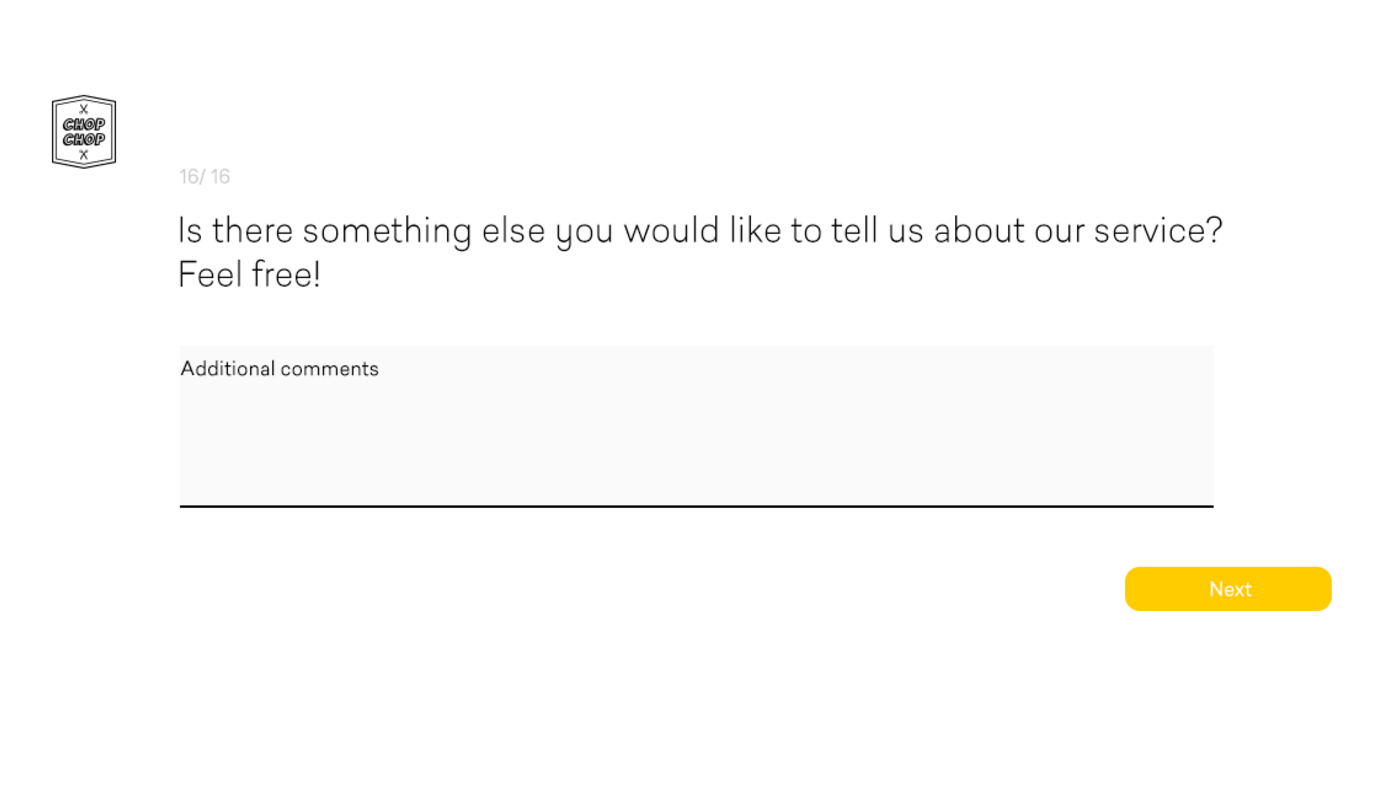
Closed-ended questions are more common in quantitative surveys. They allow us to very quickly gather large amounts of data. What’s more, narrowing down the possible answers makes it easier for researchers to analyze and interpret the results, and respondents with limited time or mobile devices are more likely to answer closed-ended questions.
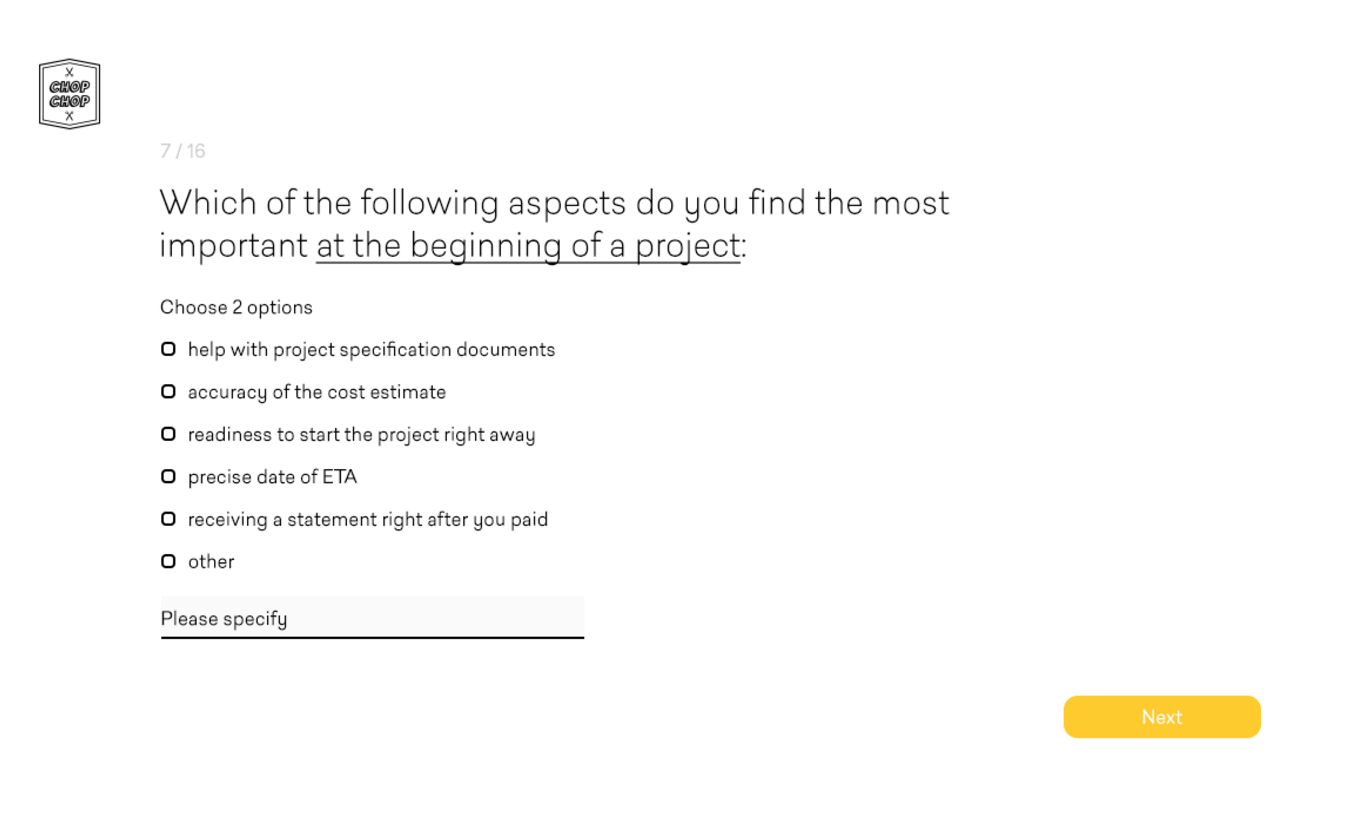
Ending
Providing closure is key to making the survey a good experience for the respondents. At the end of the survey, provide another message reassuring them that their input was valuable. It’s typically also good practice to offer participants something in return, such as a discount or access to a demo. While this won’t improve the value of the survey for the research team, it’s a great way to further the relationship with potential future customers.
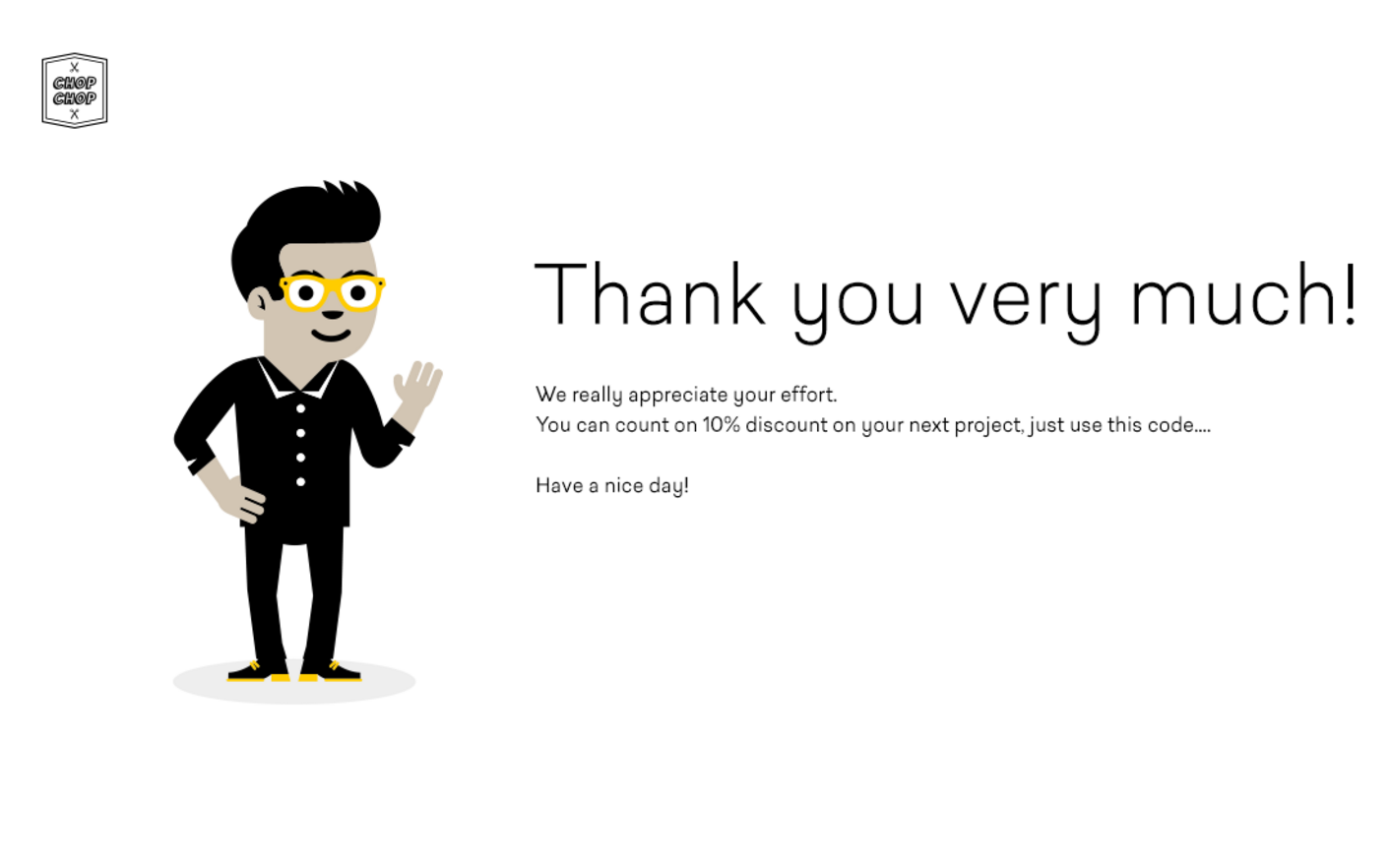
Tools for creating a survey
Once the survey is planned and crafted, there’s one last task on the list—choosing the tool to send it. Below are several good options.
Typeform
The biggest advantage of Typeform is that its interface and templates are elegant and attractive. The tool offers quite a lot in the free version, including an unlimited number of questions and custom design themes.
SurveyMonkey
SurveyMonkey offers a very useful step-by-step tutorial, but unfortunately, the free plan has some limitations: you can ask only 10 questions and the number of respondents is limited to 100. That said, the paid version starts at a fairly reasonable $26 per month, so SurveyMonkey is a good choice for teams that run surveys frequently and want a reliable tool.
Google Forms
Google Forms is a completely free online survey tool. It has plenty of useful features, however, Google doesn’t analyze the information the way SurveyMonkey does. If the researcher has the time or interest in analyzing results manually, Google Forms is a good option, but that limits its usefulness to simpler surveys.
What’s next?
Go forth and survey! Looking for more advice? Here are some additional resources for creating great surveys.
- SurveyMonkey Help Center, which offers not only instructions on using the tool but also the step-by-step survey guide, I mentioned earlier
- When to Use Which User-Experience Research Methods, by Christian Rohrer, a simple guide to choosing the right UX research method
- Social Science Research: Principles, Methods, and Practices, a comprehensive text about social science research for those who want to learn more about the survey methodology
UX research - or as it’s sometimes called, design research - informs our work, improves our understanding, and validates our decisions in the design process. In this Complete Beginner's Guide, readers will get a head start on how to use design research techniques in their work, and improve experiences for all users.